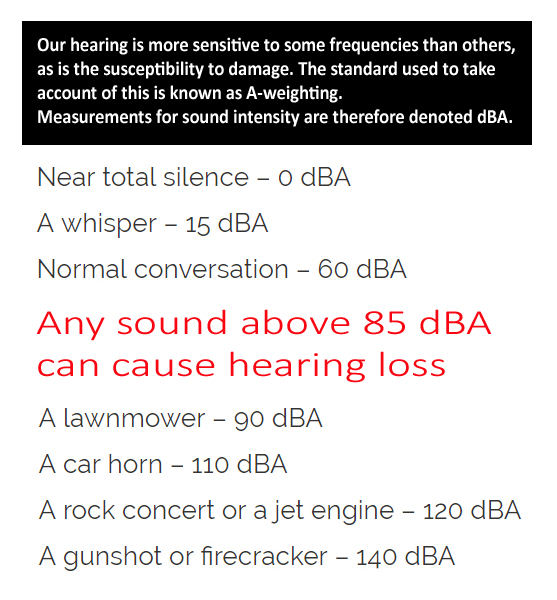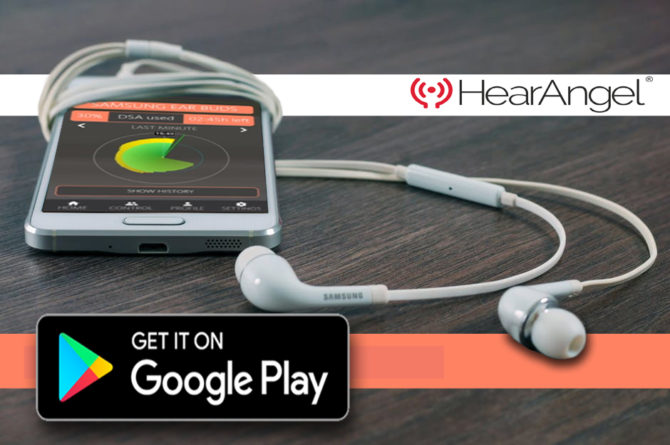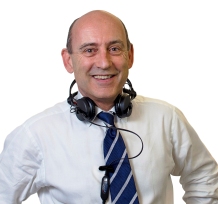7 STEPS TO PROTECT YOUR HEARING
The moment you’re born is the point at which your hearing is the best it will ever be. Once damaged, your hearing won’t miraculously recover. Hearing damage is a bit like smoking – it isn’t obvious and the effective is cumulative – you only notice once the damage has been done and then there’s simply no fix. Your hearing is precious, so look after it.
Here are seven simple tips to help you protect your hearing for life:
 Let your device be your guide
Let your device be your guide
If you’re listening on your phone or tablet, you’ll probably have noticed the high-volume warning – don’t automatically override this, instead think about why it’s there. The current World Health Organisation (WHO) recommendations are to limit your exposure to no more than 85dBA over any eight-hour period.
A smartphone can output more than 100dB – and at that volume it’s only safe to listen for up to 20 minutes in any eight-hour period before hearing is damaged. So, as pretty much every parent ever has said at some point: “Turn the volume down!”
Don’t listen in noisy environments
When you’re sitting on the train, tube or bus, it’s all too tempting to plug in your headphones and switch off from the world – it’s the wonder of modern technology. However, you’ll probably find yourself nudging up the volume to block out the extraneous noise so you can hear clearly – we tend to listen at 6-10dB above the level of the background noise.
So, if you’re on an underground train that can reach levels as high as 90-100dB (they can and often do), and attempting to get the volume above that, you’re on dangerous ground, hearing-wise.
The best thing you can do when the background noise is high is use earplugs or, if you want to listen to something, wear over-ear (preferably noise-cancelling) headphones that block out most of the noise, letting you listen comfortably at lower, less harmful levels.
Avoid noise
Too much noise can be wearing, and not just for our ears. Sometimes a little peace and quiet is exactly what you need. As our exposure to sound is calculated as an average over a 24-hour period, those quiet times will help bring the average down and your ears will benefit from a period of no or low exposure to sound.
The obvious time to achieve this level of quiet is when you’re asleep, so make your bedroom environment as quiet as possible. If you live on a busy road, this may be tricky, but double glazing and heavy-duty blackout curtains can help (they don’t just block out the light).
Equally, if you’re spending an evening in a noisy nightclub or at a concert, take a break from the noise occasionally, either by going to a quieter area or perhaps by wearing earplugs for a support band but removing them for the main act.
Get to know your dose
How long are you listening for, how loud is it, and what’s the ‘energy’ content of what you are listening to? These factors combine to give you your sound dose.
How does your sound dose compare with the hearing health recommendations? As a guide, electronic dance music is high energy – lots of beats, few gaps to recover – while speech, with lots of quiet pauses between words, is relatively low energy.
Looking at the recommendations of hearing health experts such as the WHO and the Noise at Work regulations as to what constitutes an acceptable sound level, it can be seen that their figures suggest that the magic number is 80.22dB over a 24-hour period. This is your Daily Sound Allowance (DSA®). You need to monitor this to stay safe.
 Automate your information and protection
Automate your information and protection
Useful technologies that keeps an eye on how your sound dose is building up throughout the day can do what your ears alone can’t: tell you when you’ve literally heard enough.
For example, HearAngel monitors your consumption of sound, it calculates your personal sound and provides you with information and warnings at levels you choose. Think of it as a FitBit for your ears when listening to headphones. You get to choose the right settings for you, for example, you can set one warning level at 85dB, a second at 95dB (loud!) and set a warning at 75% of recommended Daily Sound Allowance®. When you get the warning that you have used 75% of your daily allowance, you may choose to activate automatic protection, which gradually reduces the volume (so you won’t notice), but will never affect phone calls, just content, such as music, games, videos. Most people would not notice a 3dB drop in volume, so it’s a subtle process. It can even tell you how long you can carry on using your headphones for that day based on what you’ve already been listening to.
Use noise-cancelling headphones
If you use noise-cancelling headphones, you’ll find that in noisy environments you will listen at a lower volume, so you’ll be able to use your headphones three or four times longer, and you’ll be doing your long-term hearing a favour.
Earpiece-type noise-cancelling headphones will reduce ambient noise by a factor of 10, over-ear ones by 20 (their physical shape makes a more effective barrier than in-ear headphones). They work by cancelling out the noise you’re being exposed to, and they make it quieter even if you’re not actually listening to anything (useful on that noisy tube train). You’ll still have to listen at 6-10dB above the noise ‘floor’ (residual level), but as that will be much lower, the total listening level will be correspondingly lower.
Vary what you listen to
You may love nothing more than a blast of Metallica to wake you up on your morning commute, but your ears won’t thank you if you continue to listen to such high-energy music all day long. Consider your personal sound dose and, as well as spending plenty of time resting your ears without headphones, consider listening to something a little more gentle on the way home. Try a ballad, or perhaps a podcast – variety is good.
 ABOUT THE AUTHOR
ABOUT THE AUTHOR
Stephen Wheatley is CEO and a Co-Founder of HearAngel/LimitEar Ltd, which develops technologies to protect the hearing of headphone users in work and social environments. He is a technology business development specialist and has been awarded several patents for hearing safeguarding inventions for headphone users. Stephen is also a Trustee of the UK Hearing Conservation Association.
Social Media Links
Web – hearangel.com & limitear.com
Facebook LinkedIn Twitter

